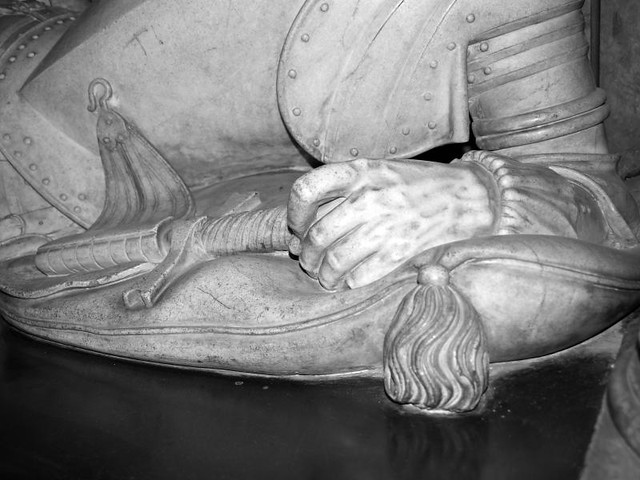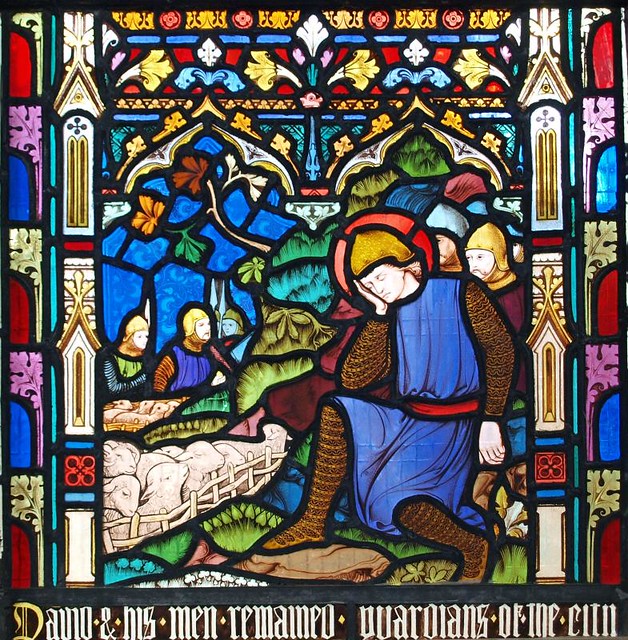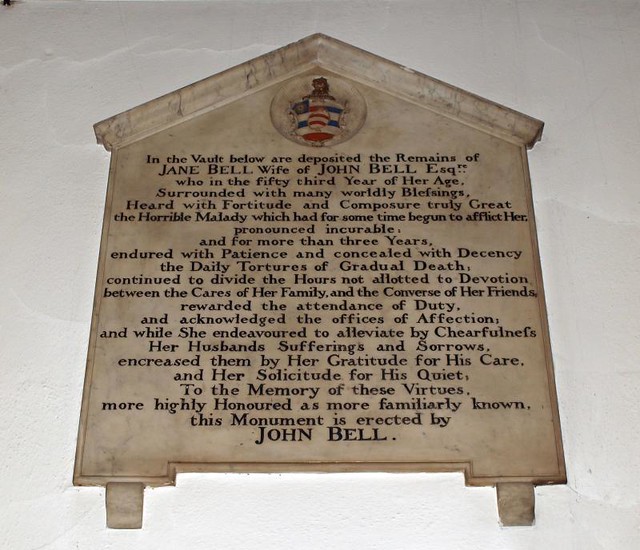ST MARY. Hidden from the High Street by a screen of low houses and placed in a large churchyard with an abundance of old trees.* The church itself is of flint, long, broad, and low, with a big, solid W tower. The tower has diagonal buttresses, battlements, a NE stair-turret, and a spike. The chancel dates from the early C13, as can be seen inside from the double Piscina and the chancel arch. Its capitals and double-chamfered arches repeat in the low long S arcade of the nave. The N arcade is C15, yet at first sight very similar. Both arcades have octagonal piers and two-centred arches. The differences lie in the taller piers, the more finely moulded capitals, and the slightly taller hollow-chamfered arches. The outer walls of the aisles, the clerestory, the nave roof with beams resting on carved angels, the S chancel chapel with tall slim octagonal pier and four-centred arches, and the tower are also C15. The N chancel chapel (Morrison Chapel) was added in 1595 (see the Tuscan columns of the arcade to the nave - cf. Hatfield church - and the mullioned and transomed E window). - PULPIT, 1714, by Richard Bull, with daintily carved borders to the panels, etc. - VESTMENT CUPBOARD, c. 1730, Flemish or French, with the four evangelists in medallions. - PLATE. Chalice, 1561; Chalice and Cover, 1610; two Flagons, 1628; two Breadholders, 1637; Almsdish, 1642. - MONUMENTS. Brasses to Hugh de Holes d. 1415 and his wife d. 1416 (?), largish figures, of good quality; the man, in judge’s robes, bigger than the woman. - Brass to three retainers of the Morrison family; two of them died in 1610 and 1613. - In the Morrison Chapel wall monument perhaps to Bridget, widow of Richard Morrison of Cassiobury and later wife of the second Earl of Bedford, who built the chapel in 1595 (no inscription): the usual kneeling figure between two columns. The monuments to her son and grandson are the chief glory of Watford church and among the best sculptural works of their date in the county. Both are by Nicholas Stone and both of alabaster and touch. Both also are of the most ambitious type: standing wall monuments with life-size figures. Sir Charles Morrison d. 1590 (made in 1619). He rests semi-reclining between columns supporting two segmental arches and a larger segmental arch above. To the l. and r. outside the columns two kneeling figures against baldacchinos of richly crumpled fabric. No Jacobean mannerisms are left, and the skill of portraiture is admirable. Opposite the monument to Sir Charles Morrison d. 1628 (‘splendidissimo et clarissimo viro’). He lies semi-reclining behind and slightly above his wife’s recumbent figure. The monument this time is a tall four-poster and above the two segmental arches are two gables. Two kneeling figures outside the columns as in the earlier monument. - Many minor later monuments, e.g. Anne Derne d. 1790, graceful epitaph of varied marbles, by J. Golde of High Holborn.
* The churchyard was altered in 1952.
Watford. It is Hertfordshire’s biggest town, and though it is fast losing its old buildings, with factories springing up in their place, it has kept something from its ancient days. There are old houses in the narrow High Street, and behind them eight 16th-century almshouses with steep gables. Close by is an imposing building of 1704, with a wooden bell turret, once the Free School. Reset in a new timbered inn at the corner of Market Street is a 15th-century oak window. Cassiobury Park, though it has seen the last of the home of the Earls of Essex, has not lost all its ancient beauty, serving now partly for golf and partly as a park where all may sit in the shade of the willows of the River Gade. Watford has about 900 acres of parks and playing fields.
The old church is tucked away behind the High Street in a large churchyard. The massive 15th-century tower with a tiny spire rises up 100 feet. The wide chancel arch is 13th century, as is the south arcade; the broad nave and aisles are 15th, with a massive roof of tie-beams supported on a dozen angels and some quaint heads left from the 13th century. The north chancel chapel was added in 1595. The altar table, the ornate chairs, and two chests are Jacobean. There is a chair of Cromwell’s time, and a tall chest of the 18th century carved with medallions of the Evangelists and their winged emblems. The 18th-century carving on the pulpit is so delicate that its craftsman (Richard Bull) is believed to have been a pupil of Grinling Gibbons. The modern choir stalls are surely unique, for among their elaborate ornament are the portraits of two curates carved as poppyheads by their vicar. On a window-sill we found a fierce-looking dragon which was once the weathervane.
On the wall behind the stalls are portraits in brass of Judge de Hollis (buried here in Agincourt year) and his wife. Kneeling in stone, a serene dignified figure at her prayer desk in the chapel she built in 1595, is the widow of Sir Richard Morrison, and a unique brass tablet on the wall portrays three faithful servants of her son’s family. The family themselves, the Morrisons, are here in two elaborate monuments by Nicholas Stone, who himself records that he carved them royally and in the best manner. We see Sir Charles Morrison lying in his armour, with his daughter, the Countess of Sussex, and his son Charles kneeling in separate recesses at each end. This same son we see again on the other monument, this time reclining on a ledge above his beautiful wife, who gazes at the canopy. At their feet kneel their two sons, and at their head kneels their daughter Elizabeth, whose own son was the first Earl of Essex of Cassiobury Park. All around are memorials of their descendants.
Remembrances of many other Watford families are in the 15th-century chapel of the Heydons of the Grove, a lovely park by the River Gade, with a stately house owned long after them by the Earl of Clarendon. An anchor memorial is to George Pidcock, who fell boarding a pirate’s junk off Amoy in 1853. Robert Clutterbuck, the famous historian of Hertfordshire, lies in the churchyard, and his son James is also remembered here; he fell carrying the colours of the West Suffolks at Inkerman. A group of officer friends who died in the Indian Mutiny have a window picturing David and Jonathan. Thomas Bevan, who was organist here for 48 years, has a window with a lovely figure of St Cecilia.
Watford has a group of modern churches of much interest. The great tower rising above the roofs with a spire turret 117 feet high belongs to the Roman Catholic church, a place of much grandeur and beauty designed by John Bentley, the architect of Westminster Cathedral. St James’s Church received as a contribution from the old church the pedestal of her Norman font, with its wavy mouldings and beaded ornament, and St John’s Church received from the old mother church her 18th-century font, which stands beside a modern stoup with two delightful cherubs. The pride of St John’s, however, is in its dark oak chapel screen with a gilded St Michael on one side and a silvered St George on the other. It is in memory of 47 men victims of the Great War, among them the famous General Maude, who lies far away at Baghdad, where he was struck down in the midst of his triumph. He was one of the bravest soldiers of the Great War, taking part in two masterly operations on Gallipoli, and leading his men with consummate genius to the relief of Kut and on to Baghdad. It was his last great victory. Baghdad was in the grip of cholera, and General Maude drank a glass of milk at a children’s party, and in four days was dead of cholera. He was a man of high integrity and deep religious faith, a bitter loss to the Army.
The old church is tucked away behind the High Street in a large churchyard. The massive 15th-century tower with a tiny spire rises up 100 feet. The wide chancel arch is 13th century, as is the south arcade; the broad nave and aisles are 15th, with a massive roof of tie-beams supported on a dozen angels and some quaint heads left from the 13th century. The north chancel chapel was added in 1595. The altar table, the ornate chairs, and two chests are Jacobean. There is a chair of Cromwell’s time, and a tall chest of the 18th century carved with medallions of the Evangelists and their winged emblems. The 18th-century carving on the pulpit is so delicate that its craftsman (Richard Bull) is believed to have been a pupil of Grinling Gibbons. The modern choir stalls are surely unique, for among their elaborate ornament are the portraits of two curates carved as poppyheads by their vicar. On a window-sill we found a fierce-looking dragon which was once the weathervane.
On the wall behind the stalls are portraits in brass of Judge de Hollis (buried here in Agincourt year) and his wife. Kneeling in stone, a serene dignified figure at her prayer desk in the chapel she built in 1595, is the widow of Sir Richard Morrison, and a unique brass tablet on the wall portrays three faithful servants of her son’s family. The family themselves, the Morrisons, are here in two elaborate monuments by Nicholas Stone, who himself records that he carved them royally and in the best manner. We see Sir Charles Morrison lying in his armour, with his daughter, the Countess of Sussex, and his son Charles kneeling in separate recesses at each end. This same son we see again on the other monument, this time reclining on a ledge above his beautiful wife, who gazes at the canopy. At their feet kneel their two sons, and at their head kneels their daughter Elizabeth, whose own son was the first Earl of Essex of Cassiobury Park. All around are memorials of their descendants.
Remembrances of many other Watford families are in the 15th-century chapel of the Heydons of the Grove, a lovely park by the River Gade, with a stately house owned long after them by the Earl of Clarendon. An anchor memorial is to George Pidcock, who fell boarding a pirate’s junk off Amoy in 1853. Robert Clutterbuck, the famous historian of Hertfordshire, lies in the churchyard, and his son James is also remembered here; he fell carrying the colours of the West Suffolks at Inkerman. A group of officer friends who died in the Indian Mutiny have a window picturing David and Jonathan. Thomas Bevan, who was organist here for 48 years, has a window with a lovely figure of St Cecilia.
Watford has a group of modern churches of much interest. The great tower rising above the roofs with a spire turret 117 feet high belongs to the Roman Catholic church, a place of much grandeur and beauty designed by John Bentley, the architect of Westminster Cathedral. St James’s Church received as a contribution from the old church the pedestal of her Norman font, with its wavy mouldings and beaded ornament, and St John’s Church received from the old mother church her 18th-century font, which stands beside a modern stoup with two delightful cherubs. The pride of St John’s, however, is in its dark oak chapel screen with a gilded St Michael on one side and a silvered St George on the other. It is in memory of 47 men victims of the Great War, among them the famous General Maude, who lies far away at Baghdad, where he was struck down in the midst of his triumph. He was one of the bravest soldiers of the Great War, taking part in two masterly operations on Gallipoli, and leading his men with consummate genius to the relief of Kut and on to Baghdad. It was his last great victory. Baghdad was in the grip of cholera, and General Maude drank a glass of milk at a children’s party, and in four days was dead of cholera. He was a man of high integrity and deep religious faith, a bitter loss to the Army.



No comments:
Post a Comment